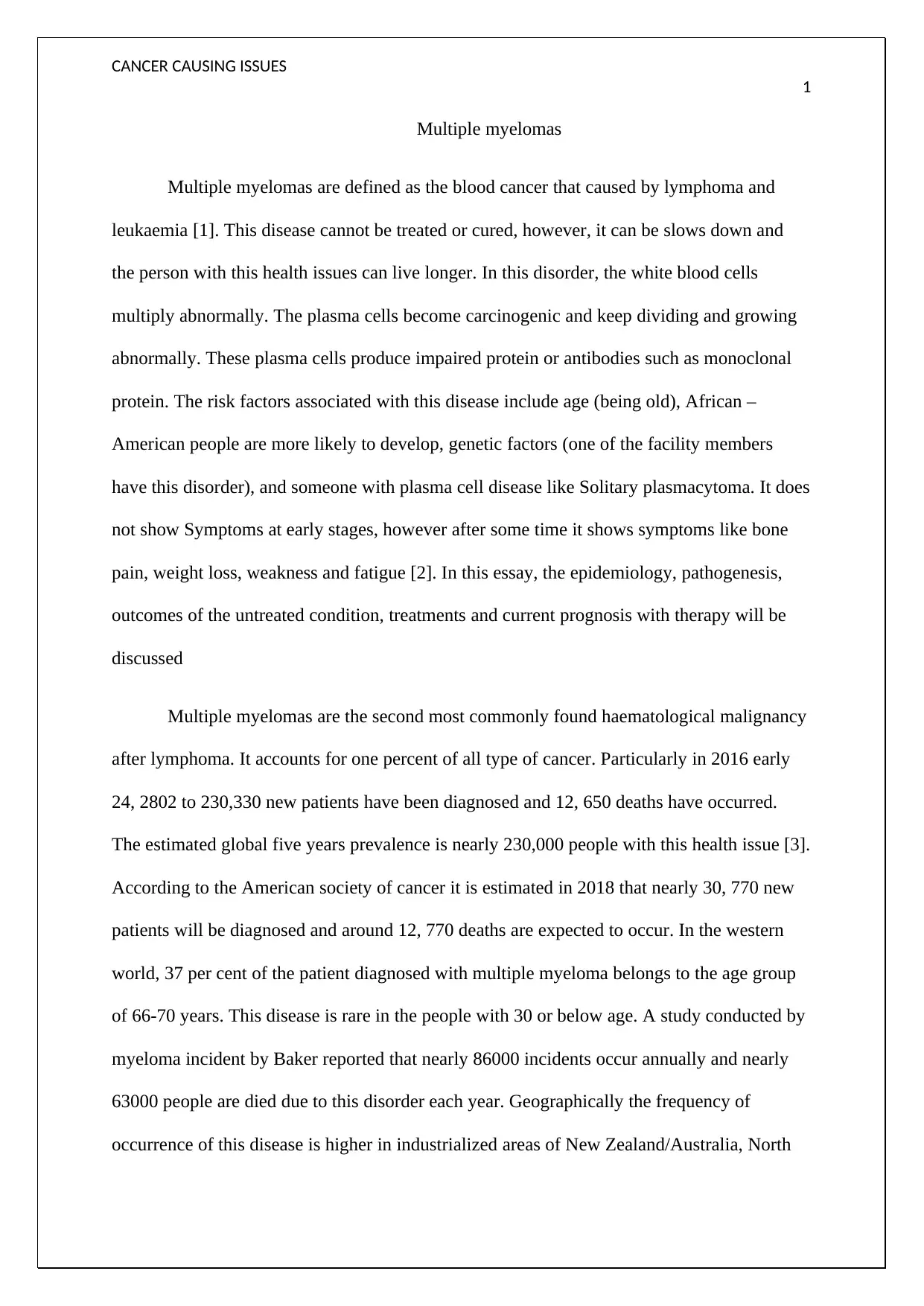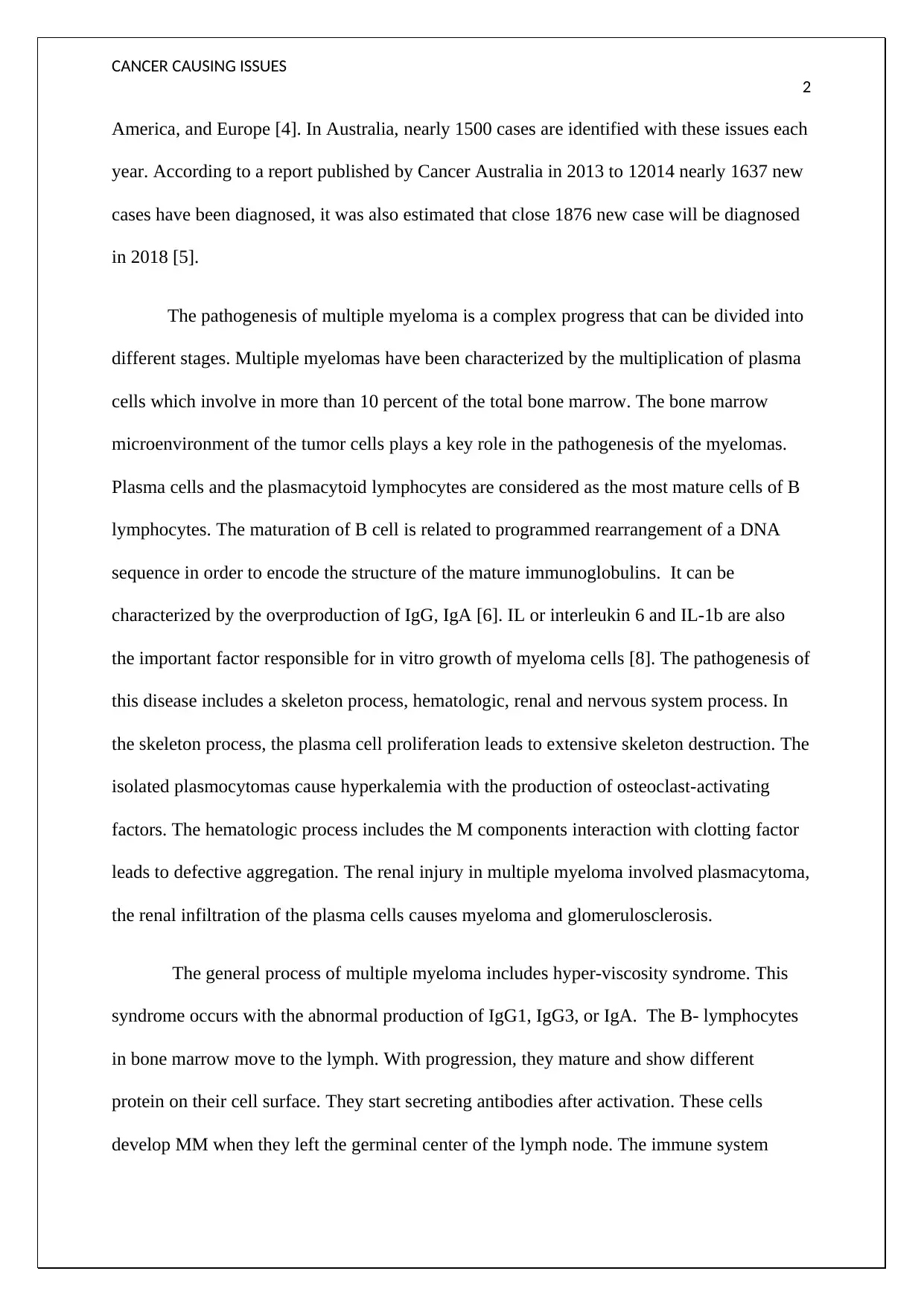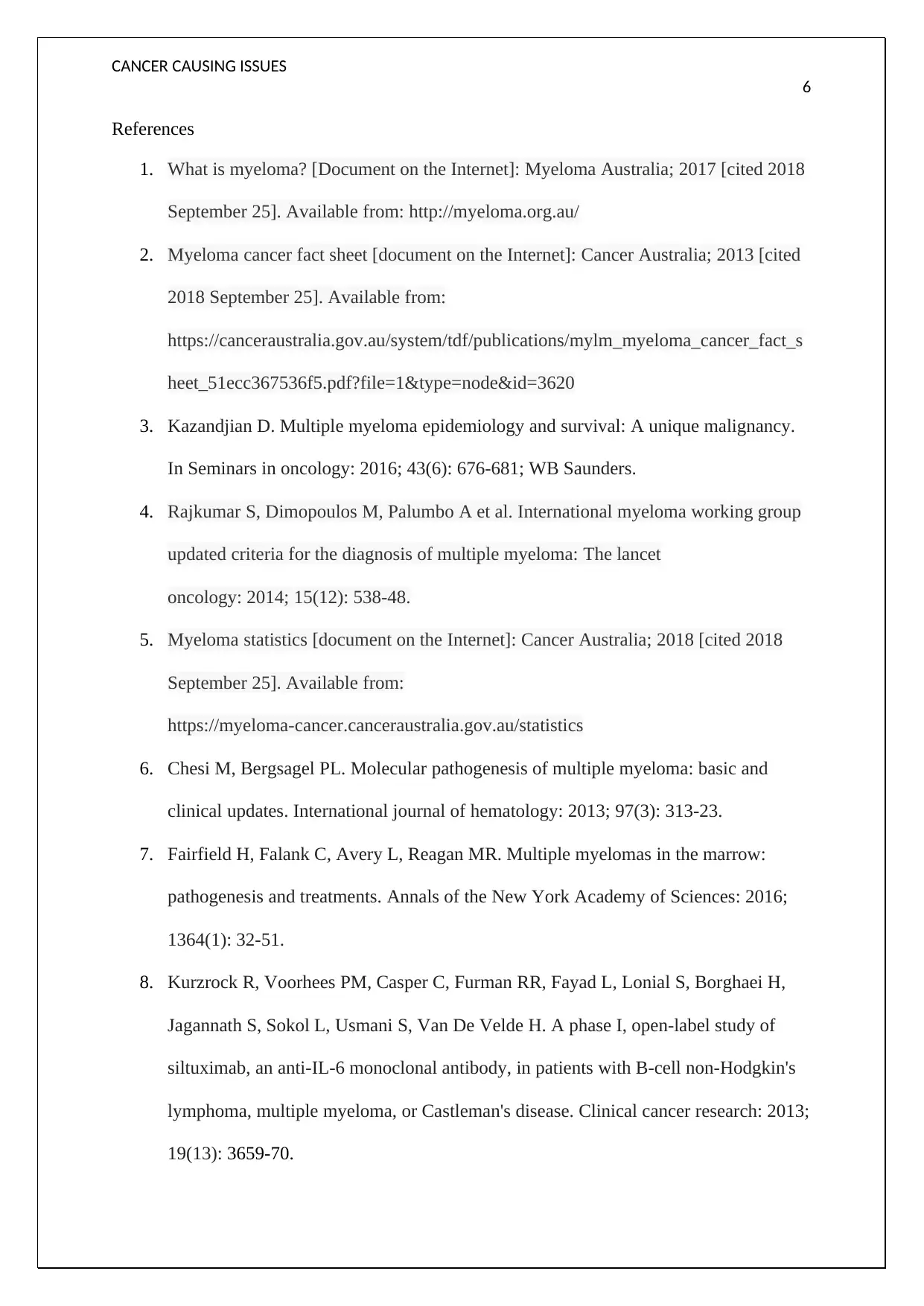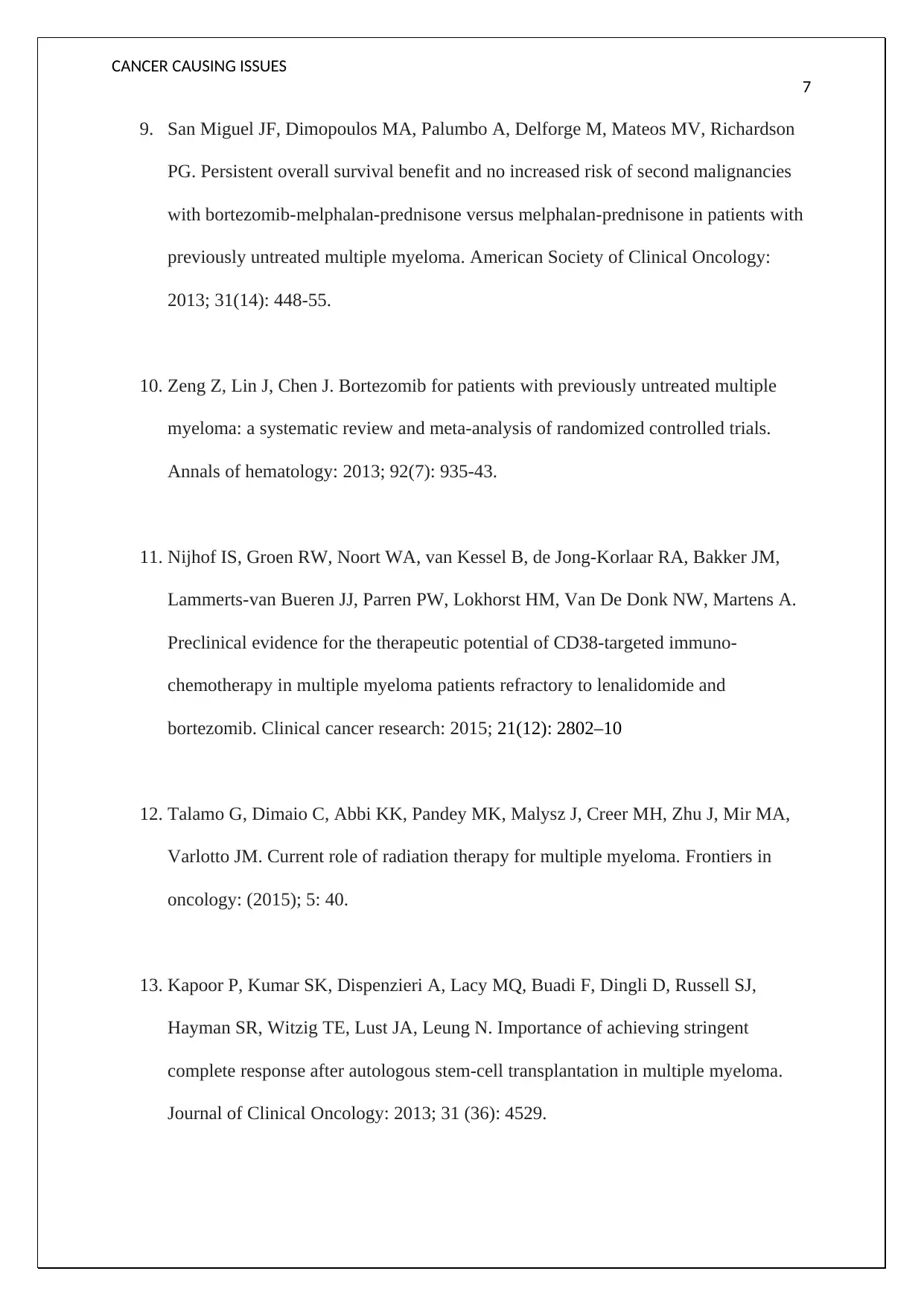Multiple Myeloma: Epidemiology, Pathogenesis, Outcomes, Treatments and Prognosis
VerifiedAdded on 2023/06/04
|9
|2439
|114
AI Summary
This essay discusses the epidemiology, pathogenesis, outcomes of the untreated condition, treatments and current prognosis with therapy of multiple myeloma, a blood cancer caused by leukaemia and lymphoma. It covers the risk factors, symptoms, and various treatments available to manage the disease.
Contribute Materials
Your contribution can guide someone’s learning journey. Share your
documents today.

Running Head: CANCER CAUSING ISSUES
0
[Type the company name]
Multiple myeloma
[Type the document subtitle]
Student name
[Pick the date]
0
[Type the company name]
Multiple myeloma
[Type the document subtitle]
Student name
[Pick the date]
Secure Best Marks with AI Grader
Need help grading? Try our AI Grader for instant feedback on your assignments.

CANCER CAUSING ISSUES
1
Multiple myelomas
Multiple myelomas are defined as the blood cancer that caused by lymphoma and
leukaemia [1]. This disease cannot be treated or cured, however, it can be slows down and
the person with this health issues can live longer. In this disorder, the white blood cells
multiply abnormally. The plasma cells become carcinogenic and keep dividing and growing
abnormally. These plasma cells produce impaired protein or antibodies such as monoclonal
protein. The risk factors associated with this disease include age (being old), African –
American people are more likely to develop, genetic factors (one of the facility members
have this disorder), and someone with plasma cell disease like Solitary plasmacytoma. It does
not show Symptoms at early stages, however after some time it shows symptoms like bone
pain, weight loss, weakness and fatigue [2]. In this essay, the epidemiology, pathogenesis,
outcomes of the untreated condition, treatments and current prognosis with therapy will be
discussed
Multiple myelomas are the second most commonly found haematological malignancy
after lymphoma. It accounts for one percent of all type of cancer. Particularly in 2016 early
24, 2802 to 230,330 new patients have been diagnosed and 12, 650 deaths have occurred.
The estimated global five years prevalence is nearly 230,000 people with this health issue [3].
According to the American society of cancer it is estimated in 2018 that nearly 30, 770 new
patients will be diagnosed and around 12, 770 deaths are expected to occur. In the western
world, 37 per cent of the patient diagnosed with multiple myeloma belongs to the age group
of 66-70 years. This disease is rare in the people with 30 or below age. A study conducted by
myeloma incident by Baker reported that nearly 86000 incidents occur annually and nearly
63000 people are died due to this disorder each year. Geographically the frequency of
occurrence of this disease is higher in industrialized areas of New Zealand/Australia, North
1
Multiple myelomas
Multiple myelomas are defined as the blood cancer that caused by lymphoma and
leukaemia [1]. This disease cannot be treated or cured, however, it can be slows down and
the person with this health issues can live longer. In this disorder, the white blood cells
multiply abnormally. The plasma cells become carcinogenic and keep dividing and growing
abnormally. These plasma cells produce impaired protein or antibodies such as monoclonal
protein. The risk factors associated with this disease include age (being old), African –
American people are more likely to develop, genetic factors (one of the facility members
have this disorder), and someone with plasma cell disease like Solitary plasmacytoma. It does
not show Symptoms at early stages, however after some time it shows symptoms like bone
pain, weight loss, weakness and fatigue [2]. In this essay, the epidemiology, pathogenesis,
outcomes of the untreated condition, treatments and current prognosis with therapy will be
discussed
Multiple myelomas are the second most commonly found haematological malignancy
after lymphoma. It accounts for one percent of all type of cancer. Particularly in 2016 early
24, 2802 to 230,330 new patients have been diagnosed and 12, 650 deaths have occurred.
The estimated global five years prevalence is nearly 230,000 people with this health issue [3].
According to the American society of cancer it is estimated in 2018 that nearly 30, 770 new
patients will be diagnosed and around 12, 770 deaths are expected to occur. In the western
world, 37 per cent of the patient diagnosed with multiple myeloma belongs to the age group
of 66-70 years. This disease is rare in the people with 30 or below age. A study conducted by
myeloma incident by Baker reported that nearly 86000 incidents occur annually and nearly
63000 people are died due to this disorder each year. Geographically the frequency of
occurrence of this disease is higher in industrialized areas of New Zealand/Australia, North

CANCER CAUSING ISSUES
2
America, and Europe [4]. In Australia, nearly 1500 cases are identified with these issues each
year. According to a report published by Cancer Australia in 2013 to 12014 nearly 1637 new
cases have been diagnosed, it was also estimated that close 1876 new case will be diagnosed
in 2018 [5].
The pathogenesis of multiple myeloma is a complex progress that can be divided into
different stages. Multiple myelomas have been characterized by the multiplication of plasma
cells which involve in more than 10 percent of the total bone marrow. The bone marrow
microenvironment of the tumor cells plays a key role in the pathogenesis of the myelomas.
Plasma cells and the plasmacytoid lymphocytes are considered as the most mature cells of B
lymphocytes. The maturation of B cell is related to programmed rearrangement of a DNA
sequence in order to encode the structure of the mature immunoglobulins. It can be
characterized by the overproduction of IgG, IgA [6]. IL or interleukin 6 and IL-1b are also
the important factor responsible for in vitro growth of myeloma cells [8]. The pathogenesis of
this disease includes a skeleton process, hematologic, renal and nervous system process. In
the skeleton process, the plasma cell proliferation leads to extensive skeleton destruction. The
isolated plasmocytomas cause hyperkalemia with the production of osteoclast-activating
factors. The hematologic process includes the M components interaction with clotting factor
leads to defective aggregation. The renal injury in multiple myeloma involved plasmacytoma,
the renal infiltration of the plasma cells causes myeloma and glomerulosclerosis.
The general process of multiple myeloma includes hyper-viscosity syndrome. This
syndrome occurs with the abnormal production of IgG1, IgG3, or IgA. The B- lymphocytes
in bone marrow move to the lymph. With progression, they mature and show different
protein on their cell surface. They start secreting antibodies after activation. These cells
develop MM when they left the germinal center of the lymph node. The immune system
2
America, and Europe [4]. In Australia, nearly 1500 cases are identified with these issues each
year. According to a report published by Cancer Australia in 2013 to 12014 nearly 1637 new
cases have been diagnosed, it was also estimated that close 1876 new case will be diagnosed
in 2018 [5].
The pathogenesis of multiple myeloma is a complex progress that can be divided into
different stages. Multiple myelomas have been characterized by the multiplication of plasma
cells which involve in more than 10 percent of the total bone marrow. The bone marrow
microenvironment of the tumor cells plays a key role in the pathogenesis of the myelomas.
Plasma cells and the plasmacytoid lymphocytes are considered as the most mature cells of B
lymphocytes. The maturation of B cell is related to programmed rearrangement of a DNA
sequence in order to encode the structure of the mature immunoglobulins. It can be
characterized by the overproduction of IgG, IgA [6]. IL or interleukin 6 and IL-1b are also
the important factor responsible for in vitro growth of myeloma cells [8]. The pathogenesis of
this disease includes a skeleton process, hematologic, renal and nervous system process. In
the skeleton process, the plasma cell proliferation leads to extensive skeleton destruction. The
isolated plasmocytomas cause hyperkalemia with the production of osteoclast-activating
factors. The hematologic process includes the M components interaction with clotting factor
leads to defective aggregation. The renal injury in multiple myeloma involved plasmacytoma,
the renal infiltration of the plasma cells causes myeloma and glomerulosclerosis.
The general process of multiple myeloma includes hyper-viscosity syndrome. This
syndrome occurs with the abnormal production of IgG1, IgG3, or IgA. The B- lymphocytes
in bone marrow move to the lymph. With progression, they mature and show different
protein on their cell surface. They start secreting antibodies after activation. These cells
develop MM when they left the germinal center of the lymph node. The immune system

CANCER CAUSING ISSUES
3
continuously produces B cells and antibodies under control. When the chromosome and
associated genes are damaged, this control has been lost. A promoter gene transfers to a
chromosome and triggers an antibody gene to abnormal production [7].
Although the symptoms of this disorder cannot be seen in early stages, it can cause
severe health issues if remain untreated. The untreated multiple myeloma can cause various
complications such as high blood calcium levels, bone pain, bacterial infection, bone breaks
or bone fractures, spinal cord compression, anemia, thickening of the blood. The symptoms
associated with the thickened blood include bleeding from the mouth and nose, blurred
vision, heart failure. Anemia related symptoms include paleness, weakness and extreme
tiredness [9]. In untreated multiple myeloma, the kidney dysfunction is commonly caused
due to the abnormal protein production form the malignant cells. The myeloma cells secrete
monoclonal proteins such as immunoglobulin. When these proteins excreted from the
kidneys, the organ gets damaged. The increased reabsorption results in hypercalcemia and
may cause nephrocalcinosis, and further leads to kidney failure. This condition may also
cause amyloidosis, and the patient with health condition develops a high level of amyloid
proteins that are secreted through the kidneys and damage one or both the kidneys and other
organs of the body. This disorder has three different stages, and in the untreated multiple
myeloma, the initial stages may reach to end stages. It may also result in increased
proliferation and the least prognosis and further, it may lead to death [10].
There are various treatments are there that are beneficial to manage the health issues.
The treatment of multiple myeloma includes chemotherapy, radiation, and bone marrow
transplant. Chemotherapy is basically the use of drugs to kill the malignant cells, generally by
preventing the cancerous cells’ ability to proliferate and grow. The chemotherapy schedules
include various cycles provided a period of time. Combining chemotherapy with other
3
continuously produces B cells and antibodies under control. When the chromosome and
associated genes are damaged, this control has been lost. A promoter gene transfers to a
chromosome and triggers an antibody gene to abnormal production [7].
Although the symptoms of this disorder cannot be seen in early stages, it can cause
severe health issues if remain untreated. The untreated multiple myeloma can cause various
complications such as high blood calcium levels, bone pain, bacterial infection, bone breaks
or bone fractures, spinal cord compression, anemia, thickening of the blood. The symptoms
associated with the thickened blood include bleeding from the mouth and nose, blurred
vision, heart failure. Anemia related symptoms include paleness, weakness and extreme
tiredness [9]. In untreated multiple myeloma, the kidney dysfunction is commonly caused
due to the abnormal protein production form the malignant cells. The myeloma cells secrete
monoclonal proteins such as immunoglobulin. When these proteins excreted from the
kidneys, the organ gets damaged. The increased reabsorption results in hypercalcemia and
may cause nephrocalcinosis, and further leads to kidney failure. This condition may also
cause amyloidosis, and the patient with health condition develops a high level of amyloid
proteins that are secreted through the kidneys and damage one or both the kidneys and other
organs of the body. This disorder has three different stages, and in the untreated multiple
myeloma, the initial stages may reach to end stages. It may also result in increased
proliferation and the least prognosis and further, it may lead to death [10].
There are various treatments are there that are beneficial to manage the health issues.
The treatment of multiple myeloma includes chemotherapy, radiation, and bone marrow
transplant. Chemotherapy is basically the use of drugs to kill the malignant cells, generally by
preventing the cancerous cells’ ability to proliferate and grow. The chemotherapy schedules
include various cycles provided a period of time. Combining chemotherapy with other
Paraphrase This Document
Need a fresh take? Get an instant paraphrase of this document with our AI Paraphraser

CANCER CAUSING ISSUES
4
treatments like radiation is recommended [11]. Radiation therapy is another approach in
which high energy x rays have been used to kill the cancerous cells. External beam radiation
therapy is commonly used in this type of treatment. Similar top chemotherapy this treatment
also proved with a set period of time [12]. The bone marrow transplant is the medical
procedures in which whole bone marrow contain malignant cells removed and replaced with
specific cells known as hematopoietic stem cells. These cells further develop in RBCs,
WBCs, and platelets in bone marrow [13]. The pharmacological treatment of multiple
myeloma includes medicine such as thalidomide, bortezomib, lenalidomide, pomalidomide,
panobinostat, carfilzomib, and daratumumab. Daratumumab is the new antibiotic treatment
which is available in the UK. It targets the protein on CD38 present on the myeloma cells and
helps to destroy the malignant myeloma cells. Panobinostat is the newer treatment for MM. it
is taken as the tablet for few months with other medicines like bortezomib. Carfilzomib is the
medication which similar to bortezomib. It is used on the regular basis as a tablet or injection
intravenously. This medicine is more intensive than bortezomib. The Bortezomib medicine
can be helpful to destroy the myeloma cells by building up proteins inside them. This can be
given through subcutaneously [14].
Multiple myelomas are the heterogeneous disorders in which the patient may survive
within the range if 1 to 10 years. The 5 years relative survival chances are 46 %. The survival
rate is higher for young people. The burden of a tumour and the rate of multiplication are two
different key indicators of prognosis in the person with this health issues. One the different
schema for predicting the survival is a use of C- reactive protein and the beta2 macroglobulin.
This can be done by methods like if the levels of both the proteins are found to be less than 6
mg/l than the median survival is fifty-four months. If the analysed level only a single
component is less than the above range, then the survival will be 27 months. If both the
protein values are higher than 6 mg/ L, this helps to predict that the median survival is six
4
treatments like radiation is recommended [11]. Radiation therapy is another approach in
which high energy x rays have been used to kill the cancerous cells. External beam radiation
therapy is commonly used in this type of treatment. Similar top chemotherapy this treatment
also proved with a set period of time [12]. The bone marrow transplant is the medical
procedures in which whole bone marrow contain malignant cells removed and replaced with
specific cells known as hematopoietic stem cells. These cells further develop in RBCs,
WBCs, and platelets in bone marrow [13]. The pharmacological treatment of multiple
myeloma includes medicine such as thalidomide, bortezomib, lenalidomide, pomalidomide,
panobinostat, carfilzomib, and daratumumab. Daratumumab is the new antibiotic treatment
which is available in the UK. It targets the protein on CD38 present on the myeloma cells and
helps to destroy the malignant myeloma cells. Panobinostat is the newer treatment for MM. it
is taken as the tablet for few months with other medicines like bortezomib. Carfilzomib is the
medication which similar to bortezomib. It is used on the regular basis as a tablet or injection
intravenously. This medicine is more intensive than bortezomib. The Bortezomib medicine
can be helpful to destroy the myeloma cells by building up proteins inside them. This can be
given through subcutaneously [14].
Multiple myelomas are the heterogeneous disorders in which the patient may survive
within the range if 1 to 10 years. The 5 years relative survival chances are 46 %. The survival
rate is higher for young people. The burden of a tumour and the rate of multiplication are two
different key indicators of prognosis in the person with this health issues. One the different
schema for predicting the survival is a use of C- reactive protein and the beta2 macroglobulin.
This can be done by methods like if the levels of both the proteins are found to be less than 6
mg/l than the median survival is fifty-four months. If the analysed level only a single
component is less than the above range, then the survival will be 27 months. If both the
protein values are higher than 6 mg/ L, this helps to predict that the median survival is six

CANCER CAUSING ISSUES
5
months. The prognosis by the treatment therapies are; in conventional therapy: the overall
survival is nearly three years, and the event-free survival is not more than two years; in high
dose chemotherapy which the stem cell transplantation: the complete survival rate is higher
than 50 percent at five years.
Multiple myeloma is the the blood cancer that is caused by leukaemia and lymphoma.
The risk factors of this disease are age, African-American people, and genetic factors. The
symptoms associated with advanced stages of this disorder include bone pain, lack of energy,
weakness, and weight loss. According to Cancer Australia between 2013 to 2014 around
1637 new case has been identified. The pathogenesis of this health issues includes the
abnormal proliferation of plasma cells during a programmed rearrangement and
overproduction of IgG, and IgG. The outcomes of the uncontrolled disorder are kidney
failure, high blood calcium level, bone pain, anaemia, thickening of blood and death.
Treatment includes chemotherapy with radiation or stem cells transplantation. Medicine like
daratumumab and carfilzomib can be used to treat or manage the disease. The prognosis of
this health issue with conventional therapy is nearly 3 years and fifty percent at 5 years in
chemotherapy with stem cell therapy.
5
months. The prognosis by the treatment therapies are; in conventional therapy: the overall
survival is nearly three years, and the event-free survival is not more than two years; in high
dose chemotherapy which the stem cell transplantation: the complete survival rate is higher
than 50 percent at five years.
Multiple myeloma is the the blood cancer that is caused by leukaemia and lymphoma.
The risk factors of this disease are age, African-American people, and genetic factors. The
symptoms associated with advanced stages of this disorder include bone pain, lack of energy,
weakness, and weight loss. According to Cancer Australia between 2013 to 2014 around
1637 new case has been identified. The pathogenesis of this health issues includes the
abnormal proliferation of plasma cells during a programmed rearrangement and
overproduction of IgG, and IgG. The outcomes of the uncontrolled disorder are kidney
failure, high blood calcium level, bone pain, anaemia, thickening of blood and death.
Treatment includes chemotherapy with radiation or stem cells transplantation. Medicine like
daratumumab and carfilzomib can be used to treat or manage the disease. The prognosis of
this health issue with conventional therapy is nearly 3 years and fifty percent at 5 years in
chemotherapy with stem cell therapy.

CANCER CAUSING ISSUES
6
References
1. What is myeloma? [Document on the Internet]: Myeloma Australia; 2017 [cited 2018
September 25]. Available from: http://myeloma.org.au/
2. Myeloma cancer fact sheet [document on the Internet]: Cancer Australia; 2013 [cited
2018 September 25]. Available from:
https://canceraustralia.gov.au/system/tdf/publications/mylm_myeloma_cancer_fact_s
heet_51ecc367536f5.pdf?file=1&type=node&id=3620
3. Kazandjian D. Multiple myeloma epidemiology and survival: A unique malignancy.
In Seminars in oncology: 2016; 43(6): 676-681; WB Saunders.
4. Rajkumar S, Dimopoulos M, Palumbo A et al. International myeloma working group
updated criteria for the diagnosis of multiple myeloma: The lancet
oncology: 2014; 15(12): 538-48.
5. Myeloma statistics [document on the Internet]: Cancer Australia; 2018 [cited 2018
September 25]. Available from:
https://myeloma-cancer.canceraustralia.gov.au/statistics
6. Chesi M, Bergsagel PL. Molecular pathogenesis of multiple myeloma: basic and
clinical updates. International journal of hematology: 2013; 97(3): 313-23.
7. Fairfield H, Falank C, Avery L, Reagan MR. Multiple myelomas in the marrow:
pathogenesis and treatments. Annals of the New York Academy of Sciences: 2016;
1364(1): 32-51.
8. Kurzrock R, Voorhees PM, Casper C, Furman RR, Fayad L, Lonial S, Borghaei H,
Jagannath S, Sokol L, Usmani S, Van De Velde H. A phase I, open-label study of
siltuximab, an anti-IL-6 monoclonal antibody, in patients with B-cell non-Hodgkin's
lymphoma, multiple myeloma, or Castleman's disease. Clinical cancer research: 2013;
19(13): 3659-70.
6
References
1. What is myeloma? [Document on the Internet]: Myeloma Australia; 2017 [cited 2018
September 25]. Available from: http://myeloma.org.au/
2. Myeloma cancer fact sheet [document on the Internet]: Cancer Australia; 2013 [cited
2018 September 25]. Available from:
https://canceraustralia.gov.au/system/tdf/publications/mylm_myeloma_cancer_fact_s
heet_51ecc367536f5.pdf?file=1&type=node&id=3620
3. Kazandjian D. Multiple myeloma epidemiology and survival: A unique malignancy.
In Seminars in oncology: 2016; 43(6): 676-681; WB Saunders.
4. Rajkumar S, Dimopoulos M, Palumbo A et al. International myeloma working group
updated criteria for the diagnosis of multiple myeloma: The lancet
oncology: 2014; 15(12): 538-48.
5. Myeloma statistics [document on the Internet]: Cancer Australia; 2018 [cited 2018
September 25]. Available from:
https://myeloma-cancer.canceraustralia.gov.au/statistics
6. Chesi M, Bergsagel PL. Molecular pathogenesis of multiple myeloma: basic and
clinical updates. International journal of hematology: 2013; 97(3): 313-23.
7. Fairfield H, Falank C, Avery L, Reagan MR. Multiple myelomas in the marrow:
pathogenesis and treatments. Annals of the New York Academy of Sciences: 2016;
1364(1): 32-51.
8. Kurzrock R, Voorhees PM, Casper C, Furman RR, Fayad L, Lonial S, Borghaei H,
Jagannath S, Sokol L, Usmani S, Van De Velde H. A phase I, open-label study of
siltuximab, an anti-IL-6 monoclonal antibody, in patients with B-cell non-Hodgkin's
lymphoma, multiple myeloma, or Castleman's disease. Clinical cancer research: 2013;
19(13): 3659-70.
Secure Best Marks with AI Grader
Need help grading? Try our AI Grader for instant feedback on your assignments.

CANCER CAUSING ISSUES
7
9. San Miguel JF, Dimopoulos MA, Palumbo A, Delforge M, Mateos MV, Richardson
PG. Persistent overall survival benefit and no increased risk of second malignancies
with bortezomib-melphalan-prednisone versus melphalan-prednisone in patients with
previously untreated multiple myeloma. American Society of Clinical Oncology:
2013; 31(14): 448-55.
10. Zeng Z, Lin J, Chen J. Bortezomib for patients with previously untreated multiple
myeloma: a systematic review and meta-analysis of randomized controlled trials.
Annals of hematology: 2013; 92(7): 935-43.
11. Nijhof IS, Groen RW, Noort WA, van Kessel B, de Jong-Korlaar RA, Bakker JM,
Lammerts-van Bueren JJ, Parren PW, Lokhorst HM, Van De Donk NW, Martens A.
Preclinical evidence for the therapeutic potential of CD38-targeted immuno-
chemotherapy in multiple myeloma patients refractory to lenalidomide and
bortezomib. Clinical cancer research: 2015; 21(12): 2802–10
12. Talamo G, Dimaio C, Abbi KK, Pandey MK, Malysz J, Creer MH, Zhu J, Mir MA,
Varlotto JM. Current role of radiation therapy for multiple myeloma. Frontiers in
oncology: (2015); 5: 40.
13. Kapoor P, Kumar SK, Dispenzieri A, Lacy MQ, Buadi F, Dingli D, Russell SJ,
Hayman SR, Witzig TE, Lust JA, Leung N. Importance of achieving stringent
complete response after autologous stem-cell transplantation in multiple myeloma.
Journal of Clinical Oncology: 2013; 31 (36): 4529.
7
9. San Miguel JF, Dimopoulos MA, Palumbo A, Delforge M, Mateos MV, Richardson
PG. Persistent overall survival benefit and no increased risk of second malignancies
with bortezomib-melphalan-prednisone versus melphalan-prednisone in patients with
previously untreated multiple myeloma. American Society of Clinical Oncology:
2013; 31(14): 448-55.
10. Zeng Z, Lin J, Chen J. Bortezomib for patients with previously untreated multiple
myeloma: a systematic review and meta-analysis of randomized controlled trials.
Annals of hematology: 2013; 92(7): 935-43.
11. Nijhof IS, Groen RW, Noort WA, van Kessel B, de Jong-Korlaar RA, Bakker JM,
Lammerts-van Bueren JJ, Parren PW, Lokhorst HM, Van De Donk NW, Martens A.
Preclinical evidence for the therapeutic potential of CD38-targeted immuno-
chemotherapy in multiple myeloma patients refractory to lenalidomide and
bortezomib. Clinical cancer research: 2015; 21(12): 2802–10
12. Talamo G, Dimaio C, Abbi KK, Pandey MK, Malysz J, Creer MH, Zhu J, Mir MA,
Varlotto JM. Current role of radiation therapy for multiple myeloma. Frontiers in
oncology: (2015); 5: 40.
13. Kapoor P, Kumar SK, Dispenzieri A, Lacy MQ, Buadi F, Dingli D, Russell SJ,
Hayman SR, Witzig TE, Lust JA, Leung N. Importance of achieving stringent
complete response after autologous stem-cell transplantation in multiple myeloma.
Journal of Clinical Oncology: 2013; 31 (36): 4529.

CANCER CAUSING ISSUES
8
14. Herndon T, Deisseroth AB, Kaminskas E, Kane RC, Koti KM, Rothmann MD,
Habtemariam BA, Bullock J, Bray JD, Hawes JH, Palmby TR. US Food and Drug
Administration approval: carfilzomib for the treatment of multiple myeloma. Clinical
cancer research: 2013; 19(17):4559-63.
8
14. Herndon T, Deisseroth AB, Kaminskas E, Kane RC, Koti KM, Rothmann MD,
Habtemariam BA, Bullock J, Bray JD, Hawes JH, Palmby TR. US Food and Drug
Administration approval: carfilzomib for the treatment of multiple myeloma. Clinical
cancer research: 2013; 19(17):4559-63.
1 out of 9
![[object Object]](/_next/static/media/star-bottom.7253800d.svg)




